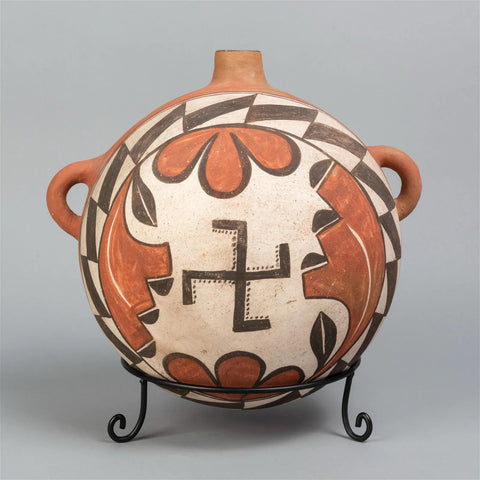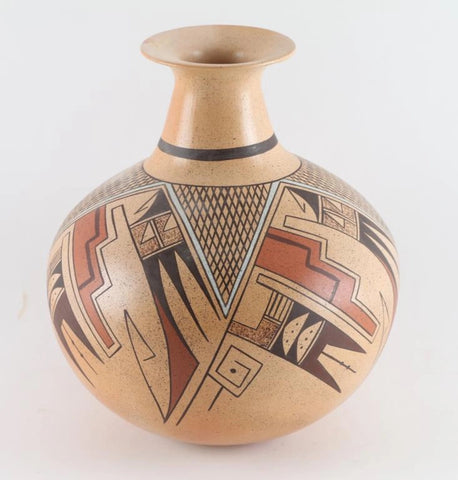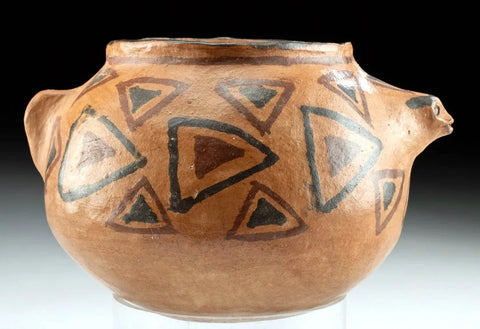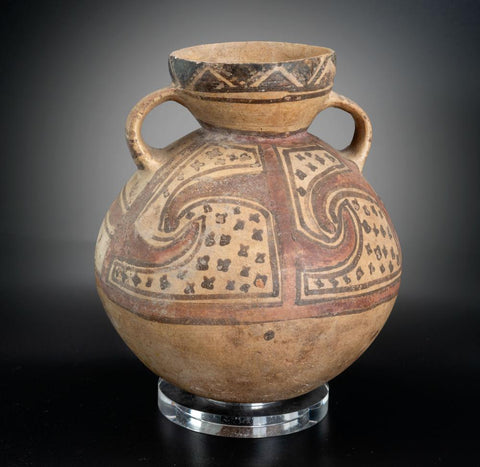
Native American, Exceptional Historic Low Shouldered Hopi Tewa Bowl, Ca 1910-1920, #1078
$ 4,800.00
Native American,
Exceptional Historic
Low Shouldered Hopi Tewa Seed Jar, Ca 1910-1920,
#1078, Native American, Exceptional Historic Low Shouldered Hopi Tewa, Seed Jar, Ca 1910-1920,
Dimensions: 8.25”x 3” height
Condition: Superb condition for the age of the piece.
Provenance: Mark Sublette via Mary and Harold Colton, Founder and Director of the museum of Northern Arizona (founded in 1928). The story on this piece is very interesting. This is what I received from David Metz, the immediate past owner of the piece.
" I believe this jar was made and painted by Nampeyo; however, as in the previous example the painting might have been done by one of her daughters, Annie – Queuchowa. The reasons I say Nampeyo and not Garnet Pavatea or her sister Myrtle Young are as such. The jar is purposely asymmetrical – a classic Nampeyo trait which I never saw in Garnet’s or Myrtle’s work, the design is purposely asymmetric – same reason as above. It has the finger indentation in the inner rim – classic Nampeyo. The jar’s bottom is rounded and as such is very much asymmetrical, as one turns the jar the view changes rather dramatically – again similar to the previous jar."
"Garnet Pavatea and Myrtle Young made very nice pottery; in many instances and without permission copied from Nampeyo and her family. However, both sisters favored flat bottoms and perfect symmetry and almost always signed their names."
"This jar was purchased from Mark Sublette, another one of the great experts in everything. He provided provenance paperwork stating the jar once belonged to Mary Colton, wife of Harold Colton, the founder and director of the museum of Northern Arizona (founded 1928). As such I originally thought this jar was made my Garnet Pavatea, as she was known to be a friend of Mary Colton and the Colton’s featured Garnet’s work for many years at the museum. However, Garnet was a known copier of Nampeyo. In fact many of her vessels are almost direct copies except that Garnet and her sister were perfectionists and Nampeyo quoting Mark Algrod from R.G. Munn “despised symmetry”. Moreover, Garnet and her sister almost always signed their work. One might conclude if Garnet made this piece for Mary Colton, she would have almost certainly signed her name as it was the Colton’s who were known to be leading advocates encouraging the Hopi potters to abandon Forgo tradition and take credit for their own work. Nampeyo never signed anything. Later in her life her youngest daughter Fannie occasionally wrote Nampeyo on the bottom of her mother’s later potteries 1930-1942 as well as the well known Nampeyo- Fannie to mean Nampeyo did the potting and Fannie the painting. At all the Pueblo’s signing or taking individual credit for anything was not an acceptable practice until about 1930."
Some background on Pueblo potter making follows:
“Pueblo pottery is made using a coiled technique that came into northern Arizona and New Mexico from the south, some 1500 years ago. In the four-corners region of the US, nineteen pueblos and villages have historically produced pottery. Although each of these pueblos use similar traditional methods of coiling, shaping, finishing and firing, the pottery from each is distinctive.
Various clay's gathered from each pueblo’s local sources produce pottery colors that range from buff to earthy yellows, oranges, and reds, as well as black. Fired pots are sometimes left plain and other times decorated—most frequently with paint and occasionally with applique. Painted designs vary from pueblo to pueblo, yet share an ancient iconography based on abstract representations of clouds, rain, feathers, birds, plants, animals and other natural world features.
Tempering materials and paints, also from natural sources, contribute further to the distinctiveness of each pueblo’s pottery. Some paints are derived from plants, others from minerals. Before firing, potters in some pueblos apply a light colored slip to their pottery, which creates a bright background for painted designs or simply a lighter color plain ware vessel. Designs are painted on before firing, traditionally with a brush fashioned from yucca fiber.
Different combinations of paint color, clay color, and slips are characteristic of different pueblos. Among them are black on cream, black on buff, black on red, dark brown and dark red on white (as found in Zuni pottery), matte red on red, and poly-chrome—a number of natural colors on one vessel (most typically associated with Hopi). Pueblo potters also produce un-decorated polished black ware, black on black ware, and carved red and carved black wares.
Making pueblo pottery is a time-consuming effort that includes gathering and preparing the clay, building and shaping the coiled pot, gathering plants to make the colored dyes, constructing yucca brushes, and, often, making a clay slip. While some Pueblo artists fire in kilns, most still fire in the traditional way in an outside fire pit, covering their vessels with large potsherds and dried sheep dung. Pottery is left to bake for many hours, producing a high-fired result.
Today, Pueblo potters continue to honor this centuries-old tradition of hand-coiled pottery production, yet value the need for contemporary artistic expression as well. They continue to improve their style, methods and designs, often combining traditional and contemporary techniques to create striking new works of art.” (Source: Museum of Northern Arizona)
Exceptional Historic
Low Shouldered Hopi Tewa Seed Jar, Ca 1910-1920,
#1078, Native American, Exceptional Historic Low Shouldered Hopi Tewa, Seed Jar, Ca 1910-1920,
Dimensions: 8.25”x 3” height
Condition: Superb condition for the age of the piece.
Provenance: Mark Sublette via Mary and Harold Colton, Founder and Director of the museum of Northern Arizona (founded in 1928). The story on this piece is very interesting. This is what I received from David Metz, the immediate past owner of the piece.
" I believe this jar was made and painted by Nampeyo; however, as in the previous example the painting might have been done by one of her daughters, Annie – Queuchowa. The reasons I say Nampeyo and not Garnet Pavatea or her sister Myrtle Young are as such. The jar is purposely asymmetrical – a classic Nampeyo trait which I never saw in Garnet’s or Myrtle’s work, the design is purposely asymmetric – same reason as above. It has the finger indentation in the inner rim – classic Nampeyo. The jar’s bottom is rounded and as such is very much asymmetrical, as one turns the jar the view changes rather dramatically – again similar to the previous jar."
"Garnet Pavatea and Myrtle Young made very nice pottery; in many instances and without permission copied from Nampeyo and her family. However, both sisters favored flat bottoms and perfect symmetry and almost always signed their names."
"This jar was purchased from Mark Sublette, another one of the great experts in everything. He provided provenance paperwork stating the jar once belonged to Mary Colton, wife of Harold Colton, the founder and director of the museum of Northern Arizona (founded 1928). As such I originally thought this jar was made my Garnet Pavatea, as she was known to be a friend of Mary Colton and the Colton’s featured Garnet’s work for many years at the museum. However, Garnet was a known copier of Nampeyo. In fact many of her vessels are almost direct copies except that Garnet and her sister were perfectionists and Nampeyo quoting Mark Algrod from R.G. Munn “despised symmetry”. Moreover, Garnet and her sister almost always signed their work. One might conclude if Garnet made this piece for Mary Colton, she would have almost certainly signed her name as it was the Colton’s who were known to be leading advocates encouraging the Hopi potters to abandon Forgo tradition and take credit for their own work. Nampeyo never signed anything. Later in her life her youngest daughter Fannie occasionally wrote Nampeyo on the bottom of her mother’s later potteries 1930-1942 as well as the well known Nampeyo- Fannie to mean Nampeyo did the potting and Fannie the painting. At all the Pueblo’s signing or taking individual credit for anything was not an acceptable practice until about 1930."
Some background on Pueblo potter making follows:
“Pueblo pottery is made using a coiled technique that came into northern Arizona and New Mexico from the south, some 1500 years ago. In the four-corners region of the US, nineteen pueblos and villages have historically produced pottery. Although each of these pueblos use similar traditional methods of coiling, shaping, finishing and firing, the pottery from each is distinctive.
Various clay's gathered from each pueblo’s local sources produce pottery colors that range from buff to earthy yellows, oranges, and reds, as well as black. Fired pots are sometimes left plain and other times decorated—most frequently with paint and occasionally with applique. Painted designs vary from pueblo to pueblo, yet share an ancient iconography based on abstract representations of clouds, rain, feathers, birds, plants, animals and other natural world features.
Tempering materials and paints, also from natural sources, contribute further to the distinctiveness of each pueblo’s pottery. Some paints are derived from plants, others from minerals. Before firing, potters in some pueblos apply a light colored slip to their pottery, which creates a bright background for painted designs or simply a lighter color plain ware vessel. Designs are painted on before firing, traditionally with a brush fashioned from yucca fiber.
Different combinations of paint color, clay color, and slips are characteristic of different pueblos. Among them are black on cream, black on buff, black on red, dark brown and dark red on white (as found in Zuni pottery), matte red on red, and poly-chrome—a number of natural colors on one vessel (most typically associated with Hopi). Pueblo potters also produce un-decorated polished black ware, black on black ware, and carved red and carved black wares.
Making pueblo pottery is a time-consuming effort that includes gathering and preparing the clay, building and shaping the coiled pot, gathering plants to make the colored dyes, constructing yucca brushes, and, often, making a clay slip. While some Pueblo artists fire in kilns, most still fire in the traditional way in an outside fire pit, covering their vessels with large potsherds and dried sheep dung. Pottery is left to bake for many hours, producing a high-fired result.
Today, Pueblo potters continue to honor this centuries-old tradition of hand-coiled pottery production, yet value the need for contemporary artistic expression as well. They continue to improve their style, methods and designs, often combining traditional and contemporary techniques to create striking new works of art.” (Source: Museum of Northern Arizona)
Related Products
Sold out









